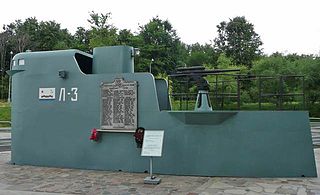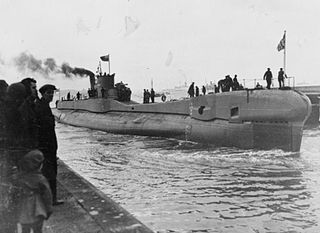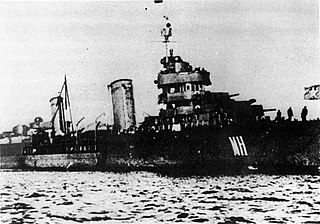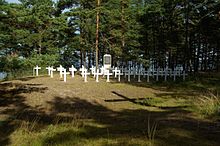
The Baltic Sea campaigns were conducted by Axis and Allied naval forces in the Baltic Sea, the Gulf of Bothnia, the Gulf of Finland and the connected lakes Ladoga and Onega on the Eastern Front of World War II. After early fighting between Polish and German forces, the main combatants were the Kriegsmarine and the Soviet Navy, with Finland supporting the Germans until 1944 and the Soviets thereafter. The Swedish Navy and merchant fleet played important roles, and the British Royal Navy planned Operation Catherine for control of the Baltic Sea and its exit choke point into the North Sea.

HNoMS Olav Tryggvason was a minelayer that was built by the naval shipyard at Horten in the early 1930s with the yard number 119. She served in the Royal Norwegian Navy until captured by the Germans in 1940. The Germans renamed her first Albatros II, and a few days later Brummer. She was wrecked in a British bombing raid in northern Germany in April 1945.

Novík was a destroyer of the Russian Imperial Navy and Soviet Navy, commissioned in 1913 where she served with the Baltic Fleet during World War I. She joined the Bolsheviks in November 1917 and was renamed Yakov Sverdlov in 1923. She was a training ship when Operation Barbarossa began, but was recalled to active duty the following day. She struck a mine on 28 August 1941 and sank while escorting an evacuation convoy during the Soviet evacuation of Tallinn.

The British campaign in the Baltic 1918–1919 was a part of the Allied intervention in the Russian Civil War. The codename of the Royal Navy campaign was Operation Red Trek. The intervention played a key role in enabling the establishment of the independent states of Estonia and Latvia. It failed to secure the control of Petrograd by White Russian forces, which was one of the main goals of the campaign.

EML Kalev was one of two submarines of the Republic of Estonia launched in 1936 at Vickers and Armstrongs Ltd. in England. Her sister, Lembit, survived the Second World War.
Juminda is a village in Kuusalu Parish, Harju County in northern Estonia. It is located on the coast of the Gulf of Finland, on top of the Juminda Peninsula, on the territory of Lahemaa National Park. Juminda has a population of 35.

Arctic naval operations of World War II were the World War II naval operations that took place in the Arctic Ocean, and can be considered part of the Battle of the Atlantic and/or of the European Theatre of World War II.
The Romanian Navy during World War II was the main Axis naval force in the Black Sea campaigns and fought against the Soviet Union's Black Sea Fleet from 1941 to 1944. Operations consisted mainly of mine warfare, but there were also escort missions and localized naval engagements. The largest naval action fought by the Romanian Navy was the 26 June 1941 Raid on Constanța, and its most extensive operation was the 1944 evacuation of the Crimea.
Submarine warfare in the Black Sea in World War II during 1942 involved engagements between primarily submarines of the Soviet Black Sea Fleet attacking Axis merchantmen defended by Romanian and German naval warships. These engagements were a part of the Black Sea campaigns between Axis and Soviet naval forces.

The Soviet submarine Baltic Sea campaign in 1941 was launched by the Soviet Navy at the early stage of Operation Barbarossa. The offensive was hampered by the quick German ground advance and the retreat of Soviet naval vessels from the main Baltic harbors.

The Soviet submarine Baltic Sea campaign in 1944 was launched by the Soviet Navy to harass enemy shipping and naval military assets of the Nazi Germany on the Eastern Front during World War II.

The Gulf of Riga campaign was fought by the Soviet Navy against the Kriegsmarine during Operation Barbarossa in 1941.

The Barents Sea campaign in 1941 was a submarine operation in the Arctic waters of the Barents Sea during World War II. It was a combined Soviet and British campaign, with boats departing from Polyarny to harass German shipping along the Norwegian coast.

Leningrad was the lead ship of her class of six destroyer flotilla leaders built for the Soviet Navy during the 1930s, one of the three Project 1 variants. Completed in 1936, the ship was assigned to the Baltic Fleet and played a minor role in the Winter War against Finland in 1939–1940. After the start of Operation Barbarossa, the German invasion of the Soviet Union in June 1941, Leningrad covered minelaying operations, laid mines herself, and provided naval gunfire support to Soviet units. She escorted ships during the evacuation of Tallinn, Estonia, in August and then bombarded German troops during the Siege of Leningrad. The ship was assigned to evacuate Soviet troops from their enclave in Hanko, Finland, in November, but was badly damaged by mines en route and forced to return to Leningrad for repairs. After they were completed, Leningrad resumed shelling German positions and continued to do so until the Leningrad–Novgorod Offensive drove them away from the city in January 1944.

Minsk was one of six Leningrad-class destroyer leaders built for the Soviet Navy during the 1930s, one of the three Project 38 variants. Completed in 1939, the ship was assigned to the Baltic Fleet and played a minor role in the Winter War against Finland in 1939–1940. After the start of Operation Barbarossa, the German invasion of the Soviet Union in June 1941, Minsk covered minelaying operations and provided naval gunfire support to Soviet units. She escorted ships during the Soviet evacuation of Tallinn, Estonia, in late August. The ship was sunk by German dive bombers on 23 September, although her wreck was salvaged in 1942 and repaired. Minsk was recommissioned in 1943 but the repairs were not completed until the following year. The ship was reclassified as a training ship in 1951, then became a target ship in 1958 and was sunk that year.

Smetlivy was one of 29 Gnevny-class destroyers built for the Soviet Navy during the late 1930s. Completed in 1938, she was assigned to the Baltic Fleet and played a minor role in the 1939–1940 Winter War against Finland. After the start of the German invasion of the Soviet Union in June 1941, the ship participated in the Gulf of Riga Campaign before withdrawing to Tallinn, Estonia. Smetlivy supported Soviet forces during the defense of Tallinn in August and covered the subsequent evacuation to Leningrad. The ship provided naval gunfire support to the defenders of Leningrad over the next several months before she was assigned to evacuate Soviet troops from their enclave in Hanko, Finland, in November. Smetlivy struck several mines returning from Hanko and sank with heavy loss of life.
Skory was one of 18 Storozhevoy-class destroyers built for the Soviet Navy during the late 1930s. Although she began construction as a Project 7 Gnevny-class destroyer, Skory was completed in 1941 to the modified Project 7U design.
Surovy was one of 18 Storozhevoy-class destroyers built for the Soviet Navy during the late 1930s. Although she began construction as a Project 7 Gnevny-class destroyer, Surovy was completed in 1941 to the modified Project 7U design.

Azard was one of eight Orfey-class destroyers built for the Russian Imperial Navy during World War I. Completed in 1916, she served with the Baltic Fleet and joined the Bolshevik Red Fleet after the October Revolution of 1918. She was active during the Russian Civil War, taking part in several engagements against British ships during the British campaign in the Baltic. The destroyer was renamed Zinoviev in 1922 and Artem in 1928. She remained in service with the Soviet Baltic Fleet when Germany invaded the Soviet Union in 1941, and was sunk by a mine on 28 August.
S-4 was an S-class submarine of the Soviet Navy. The boat entered service in the Baltic Fleet in November 1939 and took part in the Winter War and in World War II. S-4 carried out seven patrols in the Baltic Sea and sank two merchant ships for a total of 1,751 gross register tons (GRT), before being destroyed by the German torpedo boat T3 in early January 1945.

















